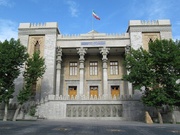The organization has also demanded explanations for the construction of a temporary bridge at the perimeter of the water system, the Khuzestan Cultural Heritage Lovers Society (Tariana) spokesman Mojtaba Gahestuni told the Persian service of the Mehr News Agency on Saturday.
The Gargar Bridge is one of 13 parts of the water system, which was registered on the UNESCO World Heritage List in 2009.
The Gargar Bridge collapsed as a result of heavy rainfall in early February. Afterward, the bridge was closed to car traffic and the Shushtar Municipality began construction of a temporary bridge in its place near the Mizan Weir.
Cultural heritage experts believe that the temporary bridge has violated the perimeter of the water system structure.
As a result, the Shushtar Municipality announced that the bridge would be removed by March 21, but the date has been postponed until July 22.
There has been slow progress in the restoration of the Gargar Bridge, Gahestuni said.
Gahestuni said that part of the wastewater from Shushtar was flushed down to the river that flows into the water system. The wastewater spreads unpleasant odors, keeping tourists and visitors away from the structure.
Shushtar’s water system structure is located near the Elamite capital of Susa in southwestern Iran. Construction of these structures started during the Achaemenid era (about 550-331 BC) on one of the Gargar River’s tributaries and the system was later improved by the Sassanid dynasty (224-651 CE).
The waterworks are comprised of bridges, dams, mills, aquifers, reservoirs, tunnels, and canals, most of which were constructed in the Sassanid period especially during the reign of Shapur I (241-272 CE).
The structures were used as an irrigation system and encouraged cultural interaction within the region. The waterfalls presented visitors with a beautiful and unique landscape, while they enjoyed the results of hydraulic engineering technology rare at that point in history.
The Shushtar waterfalls are among the few ancient water systems in Iran used for irrigating the Shushtar plain. Remnants of some of the many water wheels built at the waterfalls during the Safavid era (1501-1722) are still visible.
MMS/YAW
END
MNA
























Your Comment